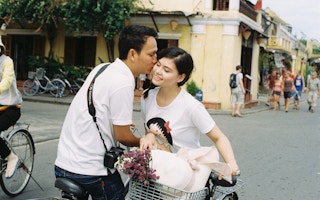Honestly, as a single person I have nothing against Valentine’s Day.
Unlike the smug couples, sulky singles or Japan’s Revolutionary Alliance of Men that Women find Unattractive who have declared that “Public smooching is terrorism” and Valentine’s Day is a capitalist ploy, I don’t have strong feelings about the former feast day of St Valentine, the patron saint of love, young people and happy marriages.
Except in one sense – how damaging this yearly indulgence is for the environment.
Consumers have been conditioned to mindlessly buy and dispose of flowers, cards, jewellery and chocolates with little thought to the consequences and Valentine’s Day has been called an environmental travesty with some justification.
Takes flowers – the top Valentine’s Day gift choice in Asia Pacific this year, according to the second annual global Mastercard Love Index.
Sprung from the bosom of Mother Nature, flowers are beautiful, sweet-smelling and inspire poetry. But industrially grown, flowers take water, light and the right temperature to come into bloom, and the 100 million roses grown for Valentine’s Day in the US alone produce 9,000 tonnes of CO2.
And let’s not forget the single-use chocolate and jewellery boxes that will be tossed out by the millions by tomorrow, plastic wrapping and ribbons from the bouquets, unrecyclable cards that will be shredded and fed to the incinerator.
If that doesn’t sound bad enough, take into account the scale of expenditure. Americans spent a record US$19.7 billion last year. The Mastercard Love Index found that even your average stoic Singaporean is ready to shell out $194 while the Chinese were the top spenders at $310 this year.
That’s a lot of money and a lot of waste in the name of love. But when you love someone, surely you want to show it without screwing the planet.
Hope springs eternal
Slowly but steadily however, couples are starting to opt to gift their significant other experiences over expensive things as a few market surveys have found.
The Mastercard Love Index, which draws its findings from credit, debit and prepaid card transactions between 2014 and 2016, found that flower sales have fallen by a third in Asia-Pacific. The bulk of a cardholder’s Valentine’s Day budget (37 per cent) is now going towards hotels or motels.
The US National Retail Foundation found that lovebirds from the millennial generation and younger are also more likely than their older counterparts to give an experience to mark Valentine’s Day.
Eloping on a weekend getaway or having an at-home spa date, how people celebrate the occasion has evolved.
According to the same study by National Retail Foundation, only 47 per cent of the lovestruck plan to give a Valentine’s Day card at all this year, compared with 63 per cent a decade ago. “Consumers might turn to emojis and Snapchat filters to share their messages of love rather than traditional cards,” the study suggests.
Companies, the main villains in the eyes of Valentine’s Day haters such as the Revolutionary Alliance of Men that Women find Unattractive and your bitter friends, are aware of changing consumer preferences and are developing more environmentally friendly products. After all there’s no reason why should St Valentine be at odds with St Francis of Assisi, the patron saint of animals and ecology.
Dunkin’ Donuts and Moët & Chandon have rolled out customisable emojis and message cards for your “bae,” maybe explain what this means while major flower exporter Colombia set up its Florverde brand of sustainable exported flowers 20 years ago with strict standards for resource and energy use and labour rights so your beau will have slavery-free blossoms. Other brands of sustainable flowers are also increasingly finding their way to market in the US.
There are ways to ensure that celebrations this Valentine’s Day – if you are compelled to celebrate it – leave a smaller footprint on the environment. Just because love is blind, doesn’t mean you have to be.
Here are a few less guilt-inducing presents for your special someone this Valentine’s Day.
1. A terrarium of succulents
Why? These hardy little fellas will always be waiting when you get home. Gorgeous and fuss-free like the SO of your dreams, they’ll probably outlive your relationship anyway.
2. Recite him/her a poem
Why? Because poems are romantic and free. Alternatively why not make your own coupons for free hugs, kisses or massages.
3. Cook something
Why? Because nothing says “I tried because I love you” like overcooked salmon and imploding creme brulee. Plus people need to eat anyway and if you finish your food – no skipping to dessert, if you know what I mean – then that’s not water, labour and resources gone to waste.
4. Gifts for a cause
Why? When you’re in love it’s hard to see beyond the two of you. But every once in a while, why not make each dollar you spend count towards something other than yourselves? Try fairtrade chocolate, handicrafts that support community programmes in Laos, adopting a vaquita or virtually sending one of WWF’s Valentine’s Day Wildcards in support of endangered animals.


















